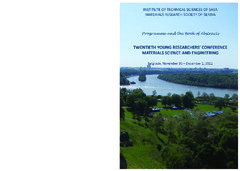Prikaz osnovnih podataka o dokumentu
Innovative nondestructive optical method for plant overall health evaluation
| dc.creator | Miletić, Katarina | |
| dc.creator | Mošić, Miloš | |
| dc.creator | Milutinović, Marijana | |
| dc.creator | Šušić, Nikola | |
| dc.creator | Kasalica, Vidoje | |
| dc.date.accessioned | 2023-08-09T07:59:49Z | |
| dc.date.available | 2023-08-09T07:59:49Z | |
| dc.date.issued | 2022 | |
| dc.identifier.isbn | 978-86-80321-37-0 | |
| dc.identifier.uri | http://rimsi.imsi.bg.ac.rs/handle/123456789/2053 | |
| dc.description.abstract | In vivo measurements of the optical properties of plant leaves, by spectrophotometric methods, could potentially provide very useful information considering plant's health. This research is focused on developing nondestructive optical processing method to obtain useful information for overall plant health evaluation. The analyses of the leaf spectroscopy (in the broad wavelength range) is well present in majority of the literature. The absorption spectra of chloroplast pigments provide clues to the relative effectiveness of different wavelengths for driving photosynthesis, since light can perform work in chloroplasts only if it is absorbed. This experimental procedure describes a novel experimental setup that enables continuous measurements of the optical reflection and transmission coefficients of broad-leaved plants. For each of 20 channels, the source of light is a red Signal LED with the spectral emission maximum at 665 nm. Special attention is given to the development of data collection software, as well as procedures for calibration of the measuring processing system and handmade methyl methacrylate leaf holders. Monitoring the evolution of the plant activity in real-time has resulted in the graph of the spectral Circadian rhythm as a function of time. Signatures from spectroscopic optical imaging could be successfully used to track nutritional disorders before visual symptoms are observed. The setup was tested on: Ocimum basilicum L. (the plants were grown in the hydroponics); Phaseolus vulgaris L., Zea mays L. (seeds were germinated in commercial humus), Guzmania lingulata (L.) Mez, Vriesea carinata Wawra, variegated geranium (L.) L'Hér. etc. The condition of the plants under test was assessed by the more common (destructive) methods such as: measurements of the determination of the photosynthetic pigment content, dry weight determination and the efficiency of PSII. Several biological parameters were observed, calculated and compared to the graphs of optical transmission dependence in real time. Currently, we are focused to update knowledge about fast and subtle changes in chloroplast movements during dark-light- dark transition and to relate different location of chloroplast to their photosynthetic capacity. | sr |
| dc.language.iso | en | sr |
| dc.publisher | Institute of Technical Sciences of SASA | sr |
| dc.rights | openAccess | sr |
| dc.source | Twentieth Young Researchers’ Conference Materials Science and Engineering | sr |
| dc.subject | transmission | sr |
| dc.subject | plant fitness | sr |
| dc.subject | Circadian rhythm | sr |
| dc.title | Innovative nondestructive optical method for plant overall health evaluation | sr |
| dc.type | conferenceObject | sr |
| dc.rights.license | ARR | sr |
| dc.citation.epage | 52 | |
| dc.citation.spage | 52 | |
| dc.identifier.fulltext | http://rimsi.imsi.bg.ac.rs/bitstream/id/5409/bitstream_5409.pdf | |
| dc.identifier.rcub | https://hdl.handle.net/21.15107/rcub_rimsi_2053 | |
| dc.type.version | publishedVersion | sr |

